Amalie Robert Estate: 2016 Pre-Spring Culinary Inclinations
Culinary Inclinations from the
Kitchen at Amalie Robert Estate
aka “How to Eat Like a Winemaker”
Pre-Spring 2016
In the family owned and operated winery, the winemaker’s world consists of four distinct seasons: Sales, Sales, Sales and Harvest.
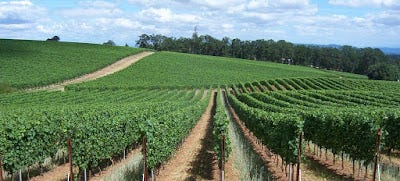
Let’s start with harvest. In 2015, harvest started in mid-September with what turned out to be a 9 bottle lot of Gewürztraminer, which by anyone’s measure is not “a lot.” Harvest continues unabated for about six weeks (can’t forget the Syrah and Viognier) and then transitions to managing fermentations which includes punch down. But you don’t hear much about punch down because the first rule of punch down is that nobody talks about punch down. Then there is the pressing of the newly fermented wine off the skins and finally, filling barrels.
While we will be among the first to come clean and admit that operating in a high cacao induced state of mind augmented with cheap caffeine can get you through harvest, it is no way to live. And this is exactly why we rarely give commentary during harvest:
Radio Personality: How is the harvest going for you at Amalie Robert Estate?
Ernie: Jacked up on chocolate and too much caffeine, this is the
best damn harvest we have ever seen!
During harvest we also have soup, warm soup if someone remembers to turn on the pan – and plug it into the wall socket. This is known as “double redundancy.” But even cold soup, with a cup of hot coffee, is not all bad. And if you keep a “power bar” in your pocket long enough you can warm it up enough to actually chew it. Just remember to take it out of your pocket before you do the laundry.
Fending off the sock monster during harvest, as you try and find a pair of semi-dry socks that are a reasonable match before heading out into the pre-dawn, requires an entirely different skill set. Of course the annual spilling of the full mug of very hot coffee is obligatory. Extra points if you avoid the groin region. It is just amazing how something so hot can get so cold so fast and last so long. Harvest season, from a culinary inclinations point of view, is not all that it’s cracked up to be.
But after what seems like an agrarian version of “Ground Hog Day” you arise one morning to find a beautiful pancetta, potato and basil frittata, crispy peppered bacon and rosemary roasted red potatoes with garlic basking in the aroma of freshly ground Italian coffee. Much akin to the Grinch on Christmas morning, you wonder “How can this be?” That is when you know the harvest season is over.
Chardonnay is the world’s most popular wine. It has many styles and interpretations throughout all wine growing regions. Chardonnay, fermented and then re-fermented in the very same bottle is not always served as a breakfast wine, but it certainly does add a little chutzpah to your brunch.
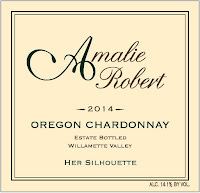
It’s hard for us to imagine anything more exhilarating than a damn fine tongue lashing of stainless steel fermented Her Silhouette Chardonnay, deftly and deliberately freeing your palate with laser like precision from the bonds of the daily grind.
Stylistically, Her Silhouette Chardonnay presents the elegant side of voluptuousness, haltered with focused acidity. We believe in restraint, leaving a bit to the imagination as it were and not the full-on décolletage that seems to be de rigueur in so many Chardonnays of today.
Culinarily, Her Silhouette Chardonnay is any easy choice for unwinding and just letting go of the guy who signaled left and turned right into your fender. That’s the adjuster’s problem now.
It’s a little bit naughty, but a nice cheeseboard can start the evening. Avoid the bread if you want to feel better about yourself in the morning, but tomorrow is a long time off - in a reality far, far away.
Regardless of the season, Her Silhouette Chardonnay is a cozy companion with a wide spectrum of shellfish – she likes them all. Winter months bring cold water oysters fresh from the Pacific Northwest – add a dash of green Tabascoif you dare. A steaming bowl of mussels or steamer clams with garlic, Andouille sausage and a hunk of sourdough bread is a guilty pleasure.
Moving away from the bivalves we enter the world of prawns and shrimps. We are nothing if not informative: Did you know in prawns the first three of the five pairs of legs on the body have small pincers, while in shrimps only two pairs are claw-like. In some shrimps one or other of the first two pairs of legs is bigger than the other whereas in prawns all the legs are similar lengths?
No matter, a quick dip in boiling water and off with their shells! Or a nice warm pan of sliced garlic, olive oil and a small (relatively speaking) dollop of butter combined with about 5 engaging minutes will result in some sumptuous “Fruits de Mer” - Fruits from the Sea. Serve over seasoned polenta for an elevated form of the southern classic “Shrimp and Grits.”
Bill Gates said it, so it must be true “Go big or go home.” Crabs and Lobster. That would be King Crabs and Australian Rock Lobsters. For these delicacies, we move to a bit more assertive Chardonnay – Heirloom Cameo.
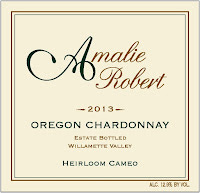
Heirloom Cameo Chardonnayis our Barrel Fermented Chardonnay or BFC. We produce a single barrel of this wine from each vintage, albeit that barrel is twice the size of our Pinot Noir barrels. Instead of wooden chocks, she is up on a powder coated steel rack – think Stilettos for Chardonnay barrels. Let’s just say she doesn’t take any “agita” from the rest of the barrels.
And she is there for a good 14 months or so, before we bring her topside for a little cold stabilization to precipitate out the tartrate crystals. These crystals are also known as “wine diamonds.” Diamonds may be a girl’s best friend, but trust us these diamonds look a lot better at the winery than in your glass.
So what does Heirloom Cameo Chardonnay bring to the party? While restraint is once again the mantra, there are varying degrees of restraint. Subject to interpretation, some would say. Others might acknowledge restraint as a concept, but prefer a bit looser interpretation.
And that big barrel is brand spanking new each year. While that is a lot of wood to take in, remember the volume of wine is more than double a smaller barrel while the surface area is less than double. The net effect is that there is more wine to less surface area. More to less or less to more depending on your interpretation. And don’t forget that firm and lengthy grip of acidity to balance it all out, we didn’t.
Sometimes the old ways are the best and boiling water is the perfect preparation for King Crab. Aioli dipping sauces can add a variation on a theme. No reason to monogamously stick to one every time, try two or three. The standard bearer is garlic aoli, but why not roasted red pepper to provide a dash of color? And they can be changed out if you find one does not perform to your satisfaction.
The Australian Rock Lobster is a bit more complicated. First off they are from down under and have travelled a great distance to be with you. Show them the respect and courtesy they deserve by cutting the tail lengthwise and broiling it for just a couple of minutes after you have had your way with them in boiling water. You will be glad you did. If you are running short on time, you can just call up the same aioli recipes from the King Crab. They were pretty good the last time, right?
The Heirloom Cameo Chardonnay can also go old school when you decide to take the afternoon off. With an ice bucket add some water, salt and enough ice to chill the wine down to no more than 55 degrees. Show her a little love in the glass and those elegant and eloquent aromas rise, instantly adding a refined motif to your afternoon hooky session.


And that brings us to that mischievous wine Our Muse Viognier. A fragrantly crisp and elegantly dry wine that is comfortable as an aperitif or in control of her own course. This wine can be easily paired with your good judgment as you begin to assemble intellectually intriguing appetizers. Our Muse can add just the right amount of inspiration and help reveal your self affirming confidence.
A hearty winter corn chowder can warm the soul and stimulate your senses. The essential components include roasted garlic, cubed roasted red potatoes, grilled corn, diced roasted red peppers, a dollop of goat cheese, a bit of fresh ginger and crumbled crispy
pepper bacon. Add steamed langoustines, but only if you want rave reviews. Combine these essentials with the chowder base of your choice. Serve with a dusting of paprika and a radiant smile.

Pinot Meunier, what a joker. This is a wine you can have “a lot” of fun with. Pour it around and tell everyone it is “Grand Cru Burgundy.” You will get away with this “mental hot foot” under two conditions: The first being if your friends have never had Grand Cru Burgundy. And second is if they know you regularly pour Grand Cru Burgundy. But why is it always from the same bottle?
Lay out a charcuterie board with a nice selection of ripe cheeses and some funky spreads. Be sure to include some Soppressata. It has great flavor and texture, but can present a challenge in pronunciation, especially after some “Grand Cru Burgundy.” Hey, who knows how to spell Gewürztraminer!? Good fun all night long…
If you are trying to impress, duck confit is the culinary equivalent to flattery. Duck confit sliders on a profiterole with caramelized red onion and calimyrna fig jam should do the trick. “Oh you shouldn’t have. Well, I can only have a taste, I started a new diet.” You will hear some very creative excuses as to why they can’t eat it, but keep an eye on the “Grand Cru Burgundy.” It will be gone, along with the duck confit sliders, before you have time to go and refill another bottle.
Chef wine. It is a problem in this country. What do you have in your glass while preparing your culinary masterpiece? Is it that left over screw-off wine that no one wanted from last week? Are you compromising your palate with that hopped-up “pine-sol” smelling craft beer? Tequila - Really? That’s great, if you are treating a snake bite or extracting a bullet.
Well, let’s just say that inspired minds need to be properly satiated. Pinot Meunier (PM) can be your “confidant,” your “palate mate,” your “work wine.” Fermented dry without commercial yeast and aged in neutral French oak barrels, this wine is all about you. Fruity one minute and suave the next, whatever you need darling, the PM is there for you. No new oak barrels to overwhelm your palate, you are able to taste flavors and nuances in your preparations unabated. Another sip as you experience your flavors coming together harmoniously. You envision the expert plating these masterpieces deserve.
And then suddenly it hits you, the bottle is empty. Waft The Fruit?? Was this the last bottle? Damnit! Call those Amalie Robert people. I need more Pinot Meunier! I haven’t finished yet. I need my “work wine!” Food and wine, it’s all about relationships.

Pinot Noir, The Seven Year Itch and “that silly white dress.” Say what you will about pop culture, though ever changing, it is alive and well. The iconic scene of Marilyn Monroe posed over a subway grate on Manhattan’s Lexington Avenue made it around the world in short order. The fact that they were out there from 1:00 in the morning for 14 takes over three hours among throngs of on-lookers should tell you something. And it still has staying power – “that silly white dress” as described by its designer, was sold for $4.6 million in 2011. That musta been some kinda itch.
Here’s how to scratch your Pinot Noir itch in 5 easy courses:
Think Pinot in Pink Rosé or the Bellpine Pearl for easing into your afternoon. Rosé of Pinot Noir has all the elegance of a white wine augmented with just a bit of texture from the brief skin contact while sporting a blush of intellectual curiosity. What color is that, and how do they get that color out of Pinot Noir?
Be it streamside with a blanket, or people watching near a subway vent, a chilled glass of Pinot Noir Rosé can help you feel right with the world. Dabble in some local crudités, paté, smoked duck breast, fresh apples, dried fruit, a bit of cheese and some warm bread and you are well on your way to a relaxing and well deserved respite from your societal obligations. They will just have to leave a message.
The Uncarved Block is our gateway Pinot Noir. Tired of doing the “Dr. Strangelove” throat grasp trying to choke down that glass of Cabernet? Ease yourself on down to some seriously sublime, whole cluster fermented Pinot Noir.


The Uncarved Block represents the diversity of our 35 acres of vines grown over sedimentary soils. The blend is 100% Estate grown Pinot Noir fermented with whole clusters and indigenous yeast, and includes all of the clones of Pinot Noir we grow throughout the vineyard.
We like to think of the kitchen as the “Command Center” (or “War Room” where fighting is not allowed) of any successful party. The opening salvo is usually something that traces back to our agrarian roots, meaning we can eat it with our fingers. For example garlic crostini topped with sundried tomatoes and pesto et al.

Crostini is a fancy word for stale bread, usually in the form of a baguette. Garlic is a wonderfully pungent, bulbous, herb. You can build a great foundation of a Napoleonic appetizer by applying garlic to crostini. Start the night before by roasting some whole garlic, or elephant garlic, depending upon your Napoleonic tendencies.
On a baking sheet arrange your sliced crostini and drizzle with rosemary infused olive oil. Using a small spoon, spread a bit of the very creamy roasted garlic over the crostini. Dust with grated Pecorino cheese. Place a few inches under the broiler to prevent incineration and remove a minute or so before you achieve spontaneous combustion.
If it weren’t for Waterloo, Napoleon would have found Springtime lavishly adorned with local basil pesto, mozzarella cheese, fresh yellow pear tomatoes, olive tapenade and a horrifically pungent, fermented “natural” beverage contained in a goat skin sealed with tree pitch and stoppered with a bit of tree bark from a nearby cork tree.
It’s nice to acknowledge our agrarian roots, but it is also worth celebrating our ability to melt sand into glass. So go ahead and layer that crostini sky high. Pull the cork on The Uncarved Block and elevate it above your favorite be-stemmed vessel then let gravity take it from there.
We speak clone: Pommard Clone, Wadenswil Clone and the Dijon Clones. While we recognize, and actively debate, the virtues of sedimentary over volcanic soils there is another case on the docket and that one shifts the focus to clonal material.
While all wine grapes, and the resulting clones of each, owe their lineage to Eurasia, the French have surreptitiously claimed the rights to the Pommard clone of Pinot Noir. Not to be outdone, the Swiss have their namesake, the Wadenswil clone. These two clones of Pinot Noir were among the first to be planted in Oregon’s Willamette Valley and they have had “a lot more than a little” influence on the standing of Oregon Pinot Noir.

The Dijon Clones, along with a couple “under the radar” clones that we just happen to grow, are the new kids on the block. The Dijon clones of Pinot Noir, along with Chardonnay, were introduced into Oregonin the 1990s due in large part to the efforts of David Adelsheim. The Dijon clones of Pinot Noir are the numbered clones including 113, 114, 115, 667 & 777. Our Dijon clones of Chardonnay are 76 and 95.
While it is true that youth and good intention make a potent mix, there is no substitute for the voice of experience and vine age. If you are looking for old vine Oregon Pinot Noir, you will most likely be enjoying one or a blend of Pommard and Wadenswil clones.
The Pommard clone is the world’s most widely planted clone of Pinot Noir for a reason – It makes really farmin’ good wine. Tended intentionally and farmed with precision this clone reveals a broad and deep expression of Pinot Noir aromas, flavors and textures.

The Wadenswil clone grown on our sedimentary soils is quite a rascal. High toned and elegant red fruits awash in a vibrant, never ending field of wild flowers lead to fully developed and delineated flavors and textures with incredible staying power. Yes, Ms Andrews, the hills are alive… with Wadenswil!
The Dijonclones present a wine profile for people who are more interested in getting on the plane as opposed to getting in one. A bit rambunctious and attention seeking, these clones are not bashful in giving you a wink and a nod. We blend 5 of these clones together and that allows each to shine in a choreographed setting. A symphonic representation of Pinot Noir, the Dijon clones can provide. Any requests? Paco’s Cannon? The 1812 Overture? Bueller? Anyone?
While the winter season affords many culinary possibilities, we tend toward game, small game to be precise. Quail and duck on the wing and rabbits that dart to cover. Foraged Chanterelle and Morel mushrooms revealed to the trained eye. Root vegetables and a cornucopia of decorated squashes and gourds are plentiful.

While the method of acquisition is an exercise left to the reader, we very much enjoy pairing our clonal offerings of Pinot Noir with grilled quail. The source material should be, at a minimum, de-feathered, eviscerated and separated from all metallic objects. No one likes an unscheduled trip to the dentist. A little prep work in advance to de-bone these birds, or acquiring semi-boneless quail from the semi-boneless quail ranch, will pay significant dividends, and elicit great compliments at the table.
As the grill warms to your ministrations, remove the quail from their overnight marinate of olive oil and fresh rosemary. Sprinkle the shining fowl with Hungarian smoked paprika and a wee bit of white pepper. You can add black sesame seeds to help disguise a “naturally” harvested bird. They have had a hard 24 hours so let them rest at room temperature.
As your sous-chef cleans the foraged mushrooms releasing the heady scents of the forest floor, you can begin prepping the smoked blue cheese stuffed, prosciutto wrapped Brown Turkey figs. This may also be the proper time to open the Dijon Clones and assess the bouquet, if not also the flavor and texture. Re-sample as you deem necessary to document the wine’s development.
While it may be the dead of winter at the 45thparallel, asparagus is ripe for the grill from the southern states. Wrap them tightly in prosciutto and they will return with a beautiful patina from the grill.
At this point you should be ready to add your foraged mushrooms to the risotto. Gently fold them in with just a tad more Pecorino and a splash of that Sauvingon Blanc that showed up like a bad penny. A little Pommard Clone Pinot Noir would go a long way in relieving that untenable situation. Use a small tasting glass, no on will notice.
Your grill, whether coal fired or reflecting the soft glow of molten steel should be ready for the expertly seasoned quail. Celebrate your inner Chef de Cuisine with just a sip more Pommard Clone Pinot Noir, even if you have to open a second bottle to do so.
As you roll the asparagus and turn the quail for the final sear, your sous-chef plates the expertly roasted figs. You smell the heady aroma that only winter risotto can conjure. The serving platter arrives as if by divine intervention and you remove the asparagus and quail at the immaculate moment of perfection.
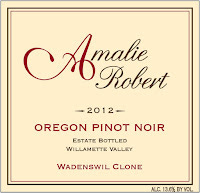
The quail are plated and you drizzle them with the sweet, rich, salty drippings from the Smoked Blue Cheese stuffed and prosciutto wrapped Brown Turkey fig pan. The asparagus receives a dusting of Percorino and a splash of finely aged Balsamic Vinegar. Your sous-chef delivers a stem of Wadenswil Clone Pinot Noir as everyone toasts your efforts. Yeah, you nailed this! As you look around the table you are overcome with the feeling that this is simply too good for mere mortals. Next year set a place for Bacchus and Dionysus, but put them across the table from Zeus. See who notices.
Once you get past all the soils and clones that help shape the aromas and flavors of Pinot noir on the vine, aka winegrowing, you move into the realm of the blending, aka winemaking. And blending takes an experienced palate, or in our case two palates – Hers and His. Amalie’s Cuvée and Estate Selection are our “Hers and His” Reserves.
Each year we select 10-12 barrels of wine that really speak to us, individually. While this may sound like a lot of fun, you are right, it is. But it also comes with great responsibility. Unlike the last minute opportunity to modify a dish before it is finished, once you have selected the barrels and made the blend there is no going back. Harvest may be the final act of winegrowing, but bottling is the final act of winemaking.
But it’s not exceedingly difficult, if you know what you are doing. And whether or not you know what you are doing, of course, is a matter of opinion. Like the two ranch hands that open the barn door after a week on the range. The first one laments at how long it is going to take to muck out the stables. The second one is all excited because, clearly, we must have gotten a new pony!
So we adhere to a very simple to apply principle: The Three Halves of Pinot Noir.
The first half of Pinot Noir is when you are looking at the wine swirling effortlessly in your stem. The bouquet rises to meet your olfactory senses and the synapses of your reptilian brain excitingly fire – It is good, put this in my mouth!
As you expertly guide the wine onto your palate your sense of taste validates your sense of aroma, but there is more, much more. Suave textures and layers compliment those taste validated aromas. But the flavors are not linear, they swirl and build and rise and fall. Whoa this is happening, right here, right now!
The third half of Pinot Noir is the lingering finish that beckons as if waking from a dream. The aromas and flavors are now an overlay on the refined tannins and wanton acidity that befit the bravado of a stolen kiss… and its defiant reception.

Amalie’s Cuvée is exceedingly well matched to Pacific Northwest Chinook Salmon. There are several species of salmon and salmon raised in several bodies of water including the Atlantic, but accept no substitutes. Pacific Northwest Chinook Salmon is the perfect foil for Amalie’s Cuvéee.
While you can always line catch your own, an experienced fishmonger is a great thing to have. We have one. They have been around since 1901 and they can ship fish to you: www.fitts.net. Depending on the intimacy of your meal, a pound of expertly cut Chinook Salmon with a bit of belly meat will endear 2 people and a glass, or maybe more, of Amalie’s Cuvée. If three is not a crowd, adjust accordingly.
A simple preparation of skin-on Chinook Salmon drizzled with olive oil and seasoned with a wee little it of fresh thyme and ground ginger in the convection oven is sublime. Roast at no more than 340 F degrees to keep all of those heart healthy fats (oils) in the meat and out of the drip pan.
Roasted red potatoes, parsnips, rutabagas and turnips with garlic and rosemary provide complimentary textures, aromas and flavors. A salad of winter greens, dried cherries and toasted hazelnuts with a balsamic vinaigrette completes your ensemble.
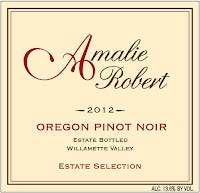
Estate Selection represents Ernie’s palate. He grew up in Montanaand well, let’s just say he likes it a bit more old world. Braised shoulder cuts with white beans, all day roast leg of something and rack of lamb are a few of his favorite things.
Ernie’s Estate Selection blend, while always subject to the annual VETO threat from Dena, tends toward a little firmer acidity and more stem tannin. But hey, they are refined tannins. And if you are going to spend an evening hanging out with tannins, they might as well be refined tannins.
Roast Frenched rack of lamb is an equally simple, and yet refined, main course. You could grow your own, and there is nothing wrong with that, but it takes a while and that emotional bond is tough to break. No matter how you get there, you will want to end up with a Frenched rack of lamb. We remove the excess fat that is usually covering the bones. Season with finely cracked black pepper, fresh thyme and have a 3 -5 inch sprig of fresh rosemary at the ready.
Once the convection oven hits 375, place the Frenched and seasoned rack of lamb in the center position. Depending on the size, roast 15 to 20 minutes and then carefully place the rosemary sprig on top of the meat and roast until the internal temperature hits 140 degrees. Allow the rack of lamb to rest for a few minutes while you pivot to the squash and garlic sautéed green beans.
A nice and colorful side is roasted delicata squash. These squash are brightly colored and shaped like a small baguette. Slice them longwise, remove the seeds and set them aside for roasting. Drizzle a bit of olive oil on the freshly cut surfaces and re-assemble the squash. Bake until firm, but yielding. Serve alongside the garlic sautéed green beans and top with your favorite grated hard cheese.
We are on a Pecorino kick right now, but you could go with Manchego or Parmigiano-Reggiano. It is OK if the shower of cheese happens to fall onto the sliced pieces of lamb. You can do it “accidentally on purpose.” We do.

The Reserve Pinot Noir is for that special, one of a kind itch. Once we agree we have found the best barrel or two in the cellar, but can’t agree who gets it, we set that wine aside and bottle it as The Reserve. All three halves of Pinot Noir are expressively represented as are our interlocked palates.
Our culinary inclination for The Reserve Pinot Noir summons Pinot Noir’s ultimate calling – roast duckling. White Pekin is the breed we choose for a flavorful, tender, and succulent Pinot Noir pairing. And White Pekin ducklings are fat free at Maple Leaf Farms. They don’t charge for the fat! They do however, charge for the shipping.
Once you have secured your White Pekin canard, you will need to forage for the appropriate accoutrements that will pay full compliments to your culinary genius. We recommend the sweet (roast husk –on corn) and savory (sautéed Brussels sprouts with bacon, garlic and onion) side of the vegetable kingdom. Now that the USDA has classified bacon as a vegetable, feel fully empowered to add a second piece.
This is not our first Pinot Noir rodeo and we just happen to have the ultimate Roast Duck write-up posted right here: Whole Roast Duck and Pinot Noir. Note: We don’t often quote ourselves, but from time to time we do find it adds interest to the topic at hand.
And of course, any proper serving of The Reserve will graciously reward a thoughtful cheese board and unscented candles. Keep an eye on that dripping wax, it can be quite hot and slow to cool. And that can be useful, when the opportunity presents itself…

While it’s true that candles dim just before revealing the full enormity of darkness, you can let our Satisfaction Syrahbe your beacon as we explore the darker side of wine (almost a bacon joke there.) The coolest part of the Syrah dominated Northern Rhône valley is Côte-Rôtie and due to its heady aromatics, it is often called the Burgundy of the Rhône. For some reason, several vineyards there have Viognier interplanted in the Syrah. We suspect it has to do with the “lack of focus and attention to detail” in the French nursery.
While we do not share much with the French (except a great passion for wine and an expertly prepared meal) we must admit we are on the same parallel. They have their bit of it and so do we, albeit several thousand miles and an ocean away. Good fences make good neighbors.
However, our joint, lateral positioning puts both Côte-Rôtie and Dallas, Oregon into the “Cool Climate Syrah” category. Our Syrah plantings cover less than an acre and represent four clones of Syrah specific to the Northern Rhône, and the randomly planted Viognier vine. It seems we also share their “lack of focus and attention to detail” in the vineyard. Très bon!
For our cool climate interpretation of Syrah, we turn our attention back to our very good dining companion, lamb. What we are recommending, advocating and generally inclined to pair with our Estate grown Satisfaction Syrah is grilled lamb T-bone steaks, chops really. Preparation here can be as simple as a sprinkling of cracked black pepper, thyme and ground ginger over the chops. Fire the grill and turn once and then just once more until just about medium to medium rare. Feed the coals a sprig or two of fresh lavender for the final touché.
Take full advantage of the hot, seasoned grill with whole parsnips and carrots to add a diversity of aromas, colors, flavors and textures. Try split and scored zucchini and yellow squash that really show off the grill marks to accentuate your grilling prowess. The foil wrapped, olive oiled and seasoned baby red potatoes are simply marvelous because you put them on the grill early, didn’t you, uh-huh. And since you will be doing the dishes, the more on the grill the better! Victoribus Spolia!
Who can call the gods is not the question, for anyone can. The question is whom will they answer. A bit like e-mail, really. The New Year is a time for reflection and change. Several people make changes during the first month of the New Year, and if they are not returning your e-mails, maybe you were one of them. But hold firm and persevere, these changes are often short lived.

What’s not short lived is our 2013 vintage Pabuk’s Gift Botrytis Chardonnay – a once in a lifetime wine. This wine represents the impossible to predict growing conditions in the Willamette Valley, the unbound curiosity by the unfamiliar of the unknown, and a longtime relationship with conspiring winemaker Dick Erath.
What started out as, and was winding down to be, the easiest harvest in Amalie Robert Estate history was inexplicably interrupted by nine inches of rain in a four day period just before harvest.
“Not good” are two words that can be published on the web without censorship, so we will go with those. What we were certain of is that the Chardonnay was going to rot, it always does, it always will.
What we didn’t know was that the rot we were about to receive would be Noble rot and not the Plebian rot we had grown annually since 2002.

When Ernie saw it was Noble rot, he felt an immediate empathy with the canine, as in “I have now caught the car. What do I do with it?” But Ernie has pockets and canines do not, so he was able to take out his cell phone and make a call.
Who to call for help? Dick Erath has seen and done more than most, and that is who Ernie called. Dick answered. And so it was.
We harvested 70 bucket of Botrytized raisins, pressed and fermented them up to about 10% alcohol. A true Trockenbeerenauslese style wine where each dried and shriveled berry was sorted by hands - Dena and Ernie’s hands to be specific.
This wine is a stunning elixir that can provide significant olfactory pleasure. However, its true calling (so far) has been Crème Brûlée and a very close second is New Yorkstyle cheese cake. So if your e-mails and phone calls are going unreturned, maybe a little Pabuk’s Gift Botrytis Chardonnay could apply the appropriate amount of persuasion you are looking for.
Kindest Regards,
Dena, Ernie and the guy in the mirror.



